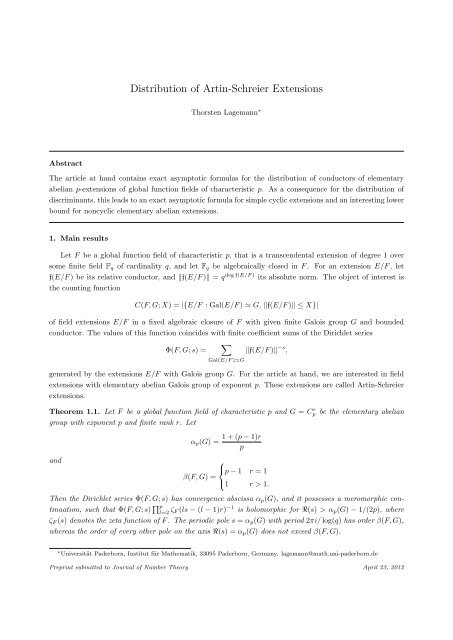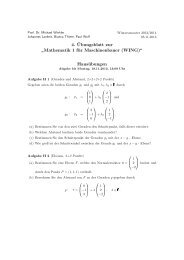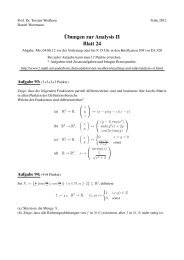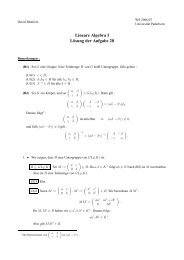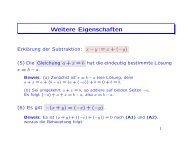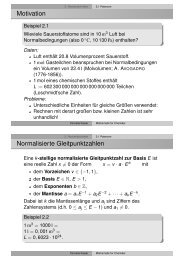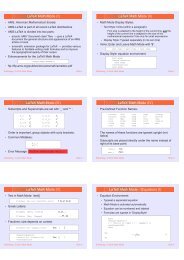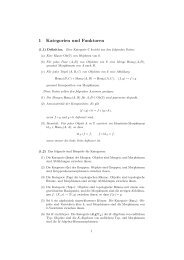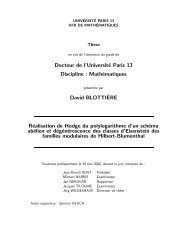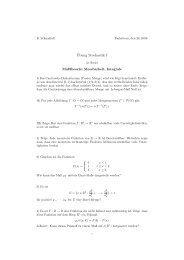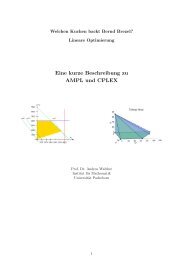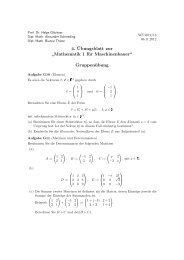Distribution of Artin-Schreier Extensions - Institut für Mathematik ...
Distribution of Artin-Schreier Extensions - Institut für Mathematik ...
Distribution of Artin-Schreier Extensions - Institut für Mathematik ...
Create successful ePaper yourself
Turn your PDF publications into a flip-book with our unique Google optimized e-Paper software.
<strong>Distribution</strong> <strong>of</strong> <strong>Artin</strong>-<strong>Schreier</strong> <strong>Extensions</strong><br />
Thorsten Lagemann ∗<br />
Abstract<br />
The article at hand contains exact asymptotic formulas for the distribution <strong>of</strong> conductors <strong>of</strong> elementary<br />
abelian p-extensions <strong>of</strong> global function fields <strong>of</strong> characteristic p. As a consequence for the distribution <strong>of</strong><br />
discriminants, this leads to an exact asymptotic formula for simple cyclic extensions and an interesting lower<br />
bound for noncyclic elementary abelian extensions.<br />
1. Main results<br />
Let F be a global function field <strong>of</strong> characteristic p, that is a transcendental extension <strong>of</strong> degree 1 over<br />
some finite field F q <strong>of</strong> cardinality q, and let F q be algebraically closed in F . For an extension E/F , let<br />
f(E/F ) be its relative conductor, and ‖f(E/F )‖ = q deg f(E/F ) its absolute norm. The object <strong>of</strong> interest is<br />
the counting function<br />
C(F, G; X) = |{E/F : Gal(E/F ) ≃ G, ‖f(E/F )‖ ≤ X}|<br />
<strong>of</strong> field extensions E/F in a fixed algebraic closure <strong>of</strong> F with given finite Galois group G and bounded<br />
conductor. The values <strong>of</strong> this function coincides with finite coefficient sums <strong>of</strong> the Dirichlet series<br />
∑<br />
Φ(F, G; s) =<br />
‖f(E/F )‖ −s ,<br />
Gal(E/F )≃G<br />
generated by the extensions E/F with Galois group G. For the article at hand, we are interested in field<br />
extensions with elementary abelian Galois group <strong>of</strong> exponent p. These extensions are called <strong>Artin</strong>-<strong>Schreier</strong><br />
extensions.<br />
Theorem 1.1. Let F be a global function field <strong>of</strong> characteristic p and G = C r p be the elementary abelian<br />
group with exponent p and finite rank r. Let<br />
and<br />
α p (G) =<br />
1 + (p − 1)r<br />
p<br />
⎧<br />
⎨p − 1 r = 1<br />
β(F, G) =<br />
⎩1 r > 1.<br />
Then the Dirichlet series Φ(F, G; s) has convergence abscissa α p (G), and it possesses a meromorphic continuation,<br />
such that Φ(F, G; s) ∏ p<br />
l=2 ζ F (ls − (l − 1)r) −1 is holomorphic for R(s) > α p (G) − 1/(2p), where<br />
ζ F (s) denotes the zeta function <strong>of</strong> F . The periodic pole s = α p (G) with period 2πi/ log(q) has order β(F, G),<br />
whereas the order <strong>of</strong> every other pole on the axis R(s) = α p (G) does not exceed β(F, G).<br />
∗ Universität Paderborn, <strong>Institut</strong> für <strong>Mathematik</strong>, 33095 Paderborn, Germany. lagemann@math.uni-paderborn.de<br />
Preprint submitted to Journal <strong>of</strong> Number Theory April 23, 2012
The series Φ(F, G; s) is a power series in t = q −s , which is convergent for |t| < q −αp(G) , and its poles are<br />
located at t = ξq −αp(G) for finitely many roots <strong>of</strong> unity ξ. If c n denotes the n-th power series coefficient <strong>of</strong><br />
Φ(F, G; s), we obtain C(F, G; q m ) = ∑ m<br />
n=0 c n. By an application <strong>of</strong> the Cauchy integral formula, which is<br />
elaborated in Theorem Appendix A.5, this coefficient sum has the following asymptotic behaviour.<br />
Theorem 1.2. Let F be a global function field <strong>of</strong> characteristic p and G = C r p be the elementary abelian<br />
group with exponent p and finite rank r. Then the number <strong>of</strong> <strong>Artin</strong>-<strong>Schreier</strong> extensions E/F with Galois<br />
group G has asymptotic<br />
C(F, G; X) ∼ γ(F, G) X αp(G) log(X) β(F,G)−1<br />
with some explicitly computable constant γ(F, G) > 0.<br />
The usage <strong>of</strong> asymptotic equivalence f(X) ∼ g(X) needs further comment. Usually this relation is<br />
defined by lim n→∞ f(n)/g(n) = 1. Here, in the function field case that is, the counting functions f(X) are<br />
step functions in X = q n , where n runs over some arithmetic progression. Hence, the limit lim n→∞ f(n)/g(n)<br />
would not exist for continuous functions g(X). Therefore, I write f(X) ∼ g(X) by abuse <strong>of</strong> notation, if<br />
there are integers l ≥ 1, e ≥ 0 with lim n→∞ f(q ln+e )/g(q ln+e ) = 1. Analogously, I will make use <strong>of</strong> f(X) ∈<br />
Ω (g(X)) for g(q ln+e ) ∈ O ( f(q ln+e ) ) , and f(X) ∈ Θ (g(X)) for f(q ln+e ) ∈ Ω ( g(q ln+e ) ) ∩ O ( g(q ln+e ) ) .<br />
This redefinition is useful if one likes to compare function field asymptotics with number field asymptotics.<br />
Note that the constant γ(F, G) in above theorem is not unique, varying by some q-powers, which depend on<br />
the chosen arithmetic progression. Disregarding this dichotomy, we obtain following formulas to compute<br />
γ(F, G) for some arithmetic progression.<br />
Addendum 1.3. For p = 2 and G = C r 2, we have<br />
γ(F, G) =<br />
where ζ F (1) denotes the residue Res s=1 (ζ F (s)).<br />
|G|<br />
|Aut(G)|<br />
Addendum 1.4. For p ≠ 2 and G = C p , we have<br />
γ(F, G) =<br />
1<br />
(p − 2)!<br />
|G|<br />
|Aut(G)|<br />
where the product runs over the primes <strong>of</strong> F .<br />
log(q) ζ F (1) p−1<br />
1 − q −1 p!<br />
log(q) ζ F (1)<br />
1 − q −(r+1) ζ F (r + 1)<br />
∏ (<br />
1 + (p − 1) ‖p‖<br />
−1 ) ( 1 − ‖p‖ −1) p−1<br />
Formulas for γ(F, C r p) with p ≠ 2, r ≠ 1 are within reach, but omitted, as they are less handy. Theorem<br />
1.2 has also consequences on the distribution <strong>of</strong> discriminants d(E/F ) <strong>of</strong> <strong>Artin</strong>-<strong>Schreier</strong> extensions<br />
E/F , which shall be elaborated and be compared to other known results in the second section. Particularly<br />
Theorem 2.1 and Theorem 2.2 are very interesting with regard <strong>of</strong> the Malle conjecture, which is also introduced<br />
in the second section. After introducing some required notations and facts on class field theory, the<br />
pro<strong>of</strong> <strong>of</strong> Theorem 1.1 starts with the fourth section, where the p-rank <strong>of</strong> ray class groups is computed. This<br />
leads to a nice local-global principle for <strong>Artin</strong>-<strong>Schreier</strong> extensions, and an explicit formula for the number<br />
c m <strong>of</strong> extensions with given conductor m in the fifth section. In the sixth section then, we are able to give<br />
an explicit description <strong>of</strong> the analytic behaviour <strong>of</strong> the Dirichlet series Φ(F, G; s), which is generated by c m .<br />
This leads to a pro<strong>of</strong> <strong>of</strong> Theorem 1.1. In the last section, Theorem 1.2 and its addenda are proven, where<br />
it is the harder part to determine the constant γ(F, G). Finally, the appendix contains a tauberian theorem<br />
for power series.<br />
2<br />
p
2. Consequences on the distribution <strong>of</strong> discriminants<br />
For given global function field F and finite group G, consider the number <strong>of</strong> field extensions E/F in a<br />
fixed algebraic closure <strong>of</strong> F with Galois group G and bounded discriminant ‖d(E/F )‖ = q deg d(E/F ) , that is<br />
the function<br />
Z(F, G; X) = |{E/F : Gal(E/F ) ≃ G, ‖d(E/F )‖ ≤ X}|.<br />
For the elementary abelian group G = C r p, let<br />
a p (G) = α p(G) 1 + (p − 1)r<br />
p r =<br />
− 1 p(p r − 1) .<br />
Then we obtain the following theorems as corollaries <strong>of</strong> Theorem 1.2 and the Führerdiskriminantenformel. 1<br />
Theorem 2.1. Let F be a global function field <strong>of</strong> characteristic p and G = C p be the simple cyclic group <strong>of</strong><br />
order p. Then the number <strong>of</strong> <strong>Artin</strong>-<strong>Schreier</strong> extensions E/F with Galois group G has asymptotic<br />
with c(F, G) = γ(F, G)/(p − 1) β(F,G)−1 .<br />
Z(F, G; X) ∼ c(F, G) X ap(G) log(X) β(F,G)−1<br />
Pro<strong>of</strong>. By the Führerdiskriminantenformel, a C p -extension with conductor f has discriminant d = f p−1 . We<br />
hence obtain the desired asymptotic formula from Theorem 1.2 and<br />
Z(F, C p ; X) = C(F, C p ; X 1/(p−1) ).<br />
Note that the factor 1/(p − 1) β(F,G)−1 <strong>of</strong> c(F, G) originates from log(X 1/(p−1) ) = log(X)/(p − 1).<br />
Theorem 2.2. Let F be a global function field <strong>of</strong> characteristic p and G = C r p be the elementary abelian<br />
group with exponent p and finite rank r. Then the number <strong>of</strong> <strong>Artin</strong>-<strong>Schreier</strong> extensions E/F with Galois<br />
group G has asymptotic<br />
(<br />
Z(F, G; X) ∈ Ω X ap(G)) .<br />
Pro<strong>of</strong>. By the Führerdiskriminantenformel, a C r p-extension with conductor f has discriminant d | f m with<br />
m = p r − 1, where equality corresponds to the case, in which every cyclic subextension has conductor f. We<br />
hence obtain<br />
by Theorem 1.2.<br />
(<br />
Z(F, Cp; r X) ≥ C(F, Cp; r X 1/m ) ∈ Ω X )) ap(Cr p<br />
,<br />
In the same matter, we are able to give an upper bound for Z(F, G; X), too. Therefore, let<br />
d p (G) =<br />
for the elementary abelian group G = C r p.<br />
α p(G)<br />
p r − p r−1 = a p(G) pr − p r−1<br />
p r − 1<br />
Theorem 2.3. Let F be a global function field <strong>of</strong> characteristic p and G = C r p be the elementary abelian<br />
group with exponent p and finite rank r. Then the number <strong>of</strong> <strong>Artin</strong>-<strong>Schreier</strong> extensions E/F with Galois<br />
group G has asymptotic<br />
(<br />
Z(F, G; X) ∈ O X dp(G)) .<br />
1 E.g. see formula (1.1) in [12].<br />
3
Pro<strong>of</strong>. Let E/F be a Cp-extension r with conductor f and discriminant d, and let E 1 , . . . , E r be a minimal<br />
set <strong>of</strong> cyclic subextensions with E = E 1 · · · E r . Since E/F has conductor f, one <strong>of</strong> the generating subfields<br />
has conductor f, too. Let E 1 be that field. By the Führerdiskriminantenformel, we now obtain f m | d with<br />
m = p r − p r−1 , where equality corresponds to the case, in which E 2 , . . . , E r are unramified. Hence, every<br />
Cp-extension r with discriminant norm X has conductor norm X 1/m at most. This results in<br />
(<br />
Z(F, Cp; r X) ≤ C(F, Cp; r X 1/m ) ∈ O X dp(Cr)) p<br />
,<br />
by Theorem 1.2.<br />
As the number <strong>of</strong> extensions with given conductor grows at least linearly with its norm, it is more likely<br />
that all generating cyclic subextensions have the same conductor than that all but one are unramified.<br />
That means, the situation as considered for the lower bound happens far more <strong>of</strong>ten than the situation as<br />
considered for the upper bound. Hence, one might ask if a p (G) already gives the X-exponent <strong>of</strong> Z(F, G; X).<br />
Lets now compare the results with the distribution <strong>of</strong> abelian groups in general. For the simple cyclic<br />
group, the formula <strong>of</strong> c(F, C p ) gives a comparable function field result to the number field formula <strong>of</strong> Henri<br />
Cohen et al. [1], which is not completely analogous though. For abelian groups with order coprime to the<br />
characteristic, we obtain the following theorem by the results <strong>of</strong> David Wright [12]. His work only lacks<br />
a handy asymptotic formula for Z(F, G; X) in the function field case, which we get by the redefinition <strong>of</strong><br />
asymptotic equivalence as described in the beginning <strong>of</strong> this article.<br />
Theorem (Wright [12]). Let F be a global function or number field <strong>of</strong> characteristic p ≥ 0 and G be a finite<br />
abelian group. Let l be the smallest prime divisor <strong>of</strong> |G|, G[l] the l-torsion group <strong>of</strong> G, and ˜F the splitting<br />
field <strong>of</strong> X l − 1 over F . Then we define<br />
a(G) =<br />
l<br />
|G[l]| − 1<br />
, b(F, G) =<br />
|G|(l − 1) [ ˜F<br />
.<br />
: F ]<br />
Now assume p ∤ |G|. Then there is a positive constant c(F, G), such that the number <strong>of</strong> G-extensions E/F<br />
has asymptotic<br />
Z(F, G; X) ∼ c(F, G) X a(G) log(X) b(F,G)−1 .<br />
Pro<strong>of</strong>. In the number field case, this is just Theorem I.2 loc. cit. In the function field case, this is the<br />
consequence <strong>of</strong> Theorem I.1 loc. cit., the discussion before Theorem I.3 loc. cit., and a tauberian theorem<br />
like Theorem Appendix A.5.<br />
This result is restricted to the case p ∤ |G|. David Wright conjectured, that the case p | |G| should behave<br />
analogously, but omitted the calculations as they are more involved. His formulas do indeed extend for the<br />
simple cyclic group C p , and might also extend for the Klein four group C 2 2 in characteristic 2. But they do<br />
not hold for any other noncyclic elementary abelian group C r p, as the lower bound in Theorem 2.2 breaks<br />
the constant a(G). This follows from the next proposition.<br />
Proposition 2.4. We have a p (C r p) = a(C r p) for C r p = C p , C 2 2, and a p (C r p) > a(C r p) otherwise.<br />
Pro<strong>of</strong>. Write a p (C r p) − a(C r p) as a fraction by extending a p (C r p) with the denominator <strong>of</strong> a(C r p) and vice<br />
versa. Then this fraction has the numerator<br />
(<br />
(r − 1) (p − 1) 2 − p ) · p r−1 + p ≥ 0,<br />
which leads to the stated proposition.<br />
4
This will have consequences on possible extensions <strong>of</strong> the Malle conjecture for global function fields.<br />
EMC (Extended Malle Conjecture). Let F be global field <strong>of</strong> characteristic p ≥ 0 and G be a finite group.<br />
Then we conjecture, that there are positive constants a(F, G), b(F, G), c(F, G), such that<br />
What are the formulas <strong>of</strong> these constants?<br />
Z(F, G; X) ∼ c(F, G) X a(F,G) log(X) b(F,G)−1 .<br />
Gunter Malle [7, 8] proposed formulas for a(F, G) = a(G) and b(F, G) in the number field case, which<br />
extend Wright’s formulas for abelian groups and other known results. While his conjecture for b(F, G) needs<br />
some adjustments [6, 11], the formula for a(F, G) = a(G), which remarkably does not depend on F , seems<br />
to be consistent for both number and function fields F with characteristic p coprime to the group order |G|.<br />
For function fields, this was shown by Jordan Ellenberg and Akshay Venkatesh [2] heuristically. With my<br />
results at hand, it is plausible that a general formula for a(F, G) including the case p | |G| is not independent<br />
<strong>of</strong> F and should at least depend on its characteristic p, a formula like a(F, G) = a p (G) for example. The<br />
main specialities <strong>of</strong> the case p | |G| are, that every prime p <strong>of</strong> F can wildly ramify in some G-extension E/F ,<br />
and it is possible to have infinitely many local G-extensions E/F p over any localisation F p . Both effects do<br />
not occur in the case p ∤ |G|, including number fields.<br />
3. Notations and preliminaries<br />
Let F denote a global function field with constant field F q <strong>of</strong> cardinality q, algebraically closed in F . For<br />
a prime p <strong>of</strong> F , let F p ≥ F q denote the residue class field, and ‖p‖ = |F p | its norm. The valuation <strong>of</strong> p is<br />
denoted by v p . Let g F be the genus, h F the class number, and Cl the class group <strong>of</strong> F . In particular, we<br />
have Cl ≃ Z × Cl[h F ]. For a module m, an effective divisor <strong>of</strong> F that is, let F m be the multiplicative group<br />
<strong>of</strong> functions x ∈ F × with divisor coprime to m, and let F m ≤ F m be the ray mod m <strong>of</strong> functions x ∈ F m<br />
with x ∈ 1 + p vp(m) for all p | m. The ray class group Cl m mod m is defined by the exact sequence <strong>of</strong> abelian<br />
groups<br />
1 → F × q → F m /F m → Cl m → Cl → 1. (1)<br />
By class field theory, there is a bijective map <strong>of</strong> finite abelian extensions E/F with module m and subgroups<br />
U ≤ Cl m <strong>of</strong> finite index, such that Gal(E/F ) ≃ Cl m /U. 2 Let U m be the following finite p-group 3<br />
U m = (F m /F m )/(F m /F m ) p ≃ ∏<br />
p m ||m<br />
U p m<br />
≃ ∏<br />
〈1 + p〉/〈〈1 + p m 〉, 〈1 + p〉 p 〉, (2)<br />
where the product is to read as follows. The relation p m || m stands for v p (m) = m > 0. For an expression<br />
f p (m), the product ∏ p m ||m f p(m) stands for ∏ p|m f p(v p (m)). For example, let f p (m) = p m−1 and we have<br />
∏<br />
p m ||m pm−1 = ∏ p|m pvp(m)−1 , which is still an effective divisor. The same definition holds for sums. For<br />
example, the divisor above has degree ∑ p m ||m (m − 1) deg p = ∑ p|m (v p(m) − 1) deg p ≥ 0. For the trivial<br />
module m = 1, these products and sums are particularly defined as empty ones. Further, let S = {x ∈ F × :<br />
(x) = a p for some divisor a}/F p be the p-Selmer group, and let S m = {[x] ∈ S : x ∈ F m } be the Selmer ray<br />
group mod m <strong>of</strong> F .<br />
p m ||m<br />
2 E.g. see page 139 and Theorem 9.23, page 140 in [9] for the sequence (1) and the <strong>Artin</strong> reciprocity law respectively.<br />
3 E.g. see section 9.2 in [4] for the isomorphisms.<br />
5
4. <strong>Artin</strong>-<strong>Schreier</strong> extensions with given module<br />
In this section, we shall compute the order <strong>of</strong> the ray class group Cl m /Cl p m. It nearly behaves multiplicatively<br />
over the prime decomposition <strong>of</strong> m, if there were not the Selmer ray group S m , whose order is not<br />
multiplicative. But as we will see, S m is trivial for almost all modules m <strong>of</strong> interest. Proposition 4.1 is the<br />
function field analogue <strong>of</strong> Proposition 2.12 in [1], and its pro<strong>of</strong> is essentially the same.<br />
Proposition 4.1. We have the exact sequence <strong>of</strong> finite abelian p-groups<br />
1 → S m → Cl[p] → U m → Cl m /Cl p m → Cl/Cl p → 1.<br />
Pro<strong>of</strong>. The sequence (1) remains right exact by tensoring with C p , and we obtain<br />
U m → Cl m /Cl p m → Cl/Cl p → 1.<br />
The kernel U ≤ U m <strong>of</strong> the first map is generated by functions x ∈ F m with divisor (x) = (y) a p and y ∈ F m .<br />
Therefore, any class [x] = [xy −1 ] in U is generated by a Selmer element [z] ∈ S with (z) = a p . Conversely,<br />
every Selmer class [x] ∈ S can be mapped in U by the approximation theorem, 4 and this map has kernel<br />
S m . Finally, we use the following isomorphism <strong>of</strong> the p-torsion group Cl[p] with the Selmer group S. For a<br />
given divisor class [a] ∈ Cl[p], there is a function z ∈ F × with divisor (z) = a p , and vice versa. Then the<br />
map [a] ↦→ [z] is well defined and provides an isomorphism Cl[p] ≃ S.<br />
Lemma 4.2. For any integer m ≥ 1, let r m = m − 1 − ⌊(m − 1)/p⌋, and r 0 = 0. Let m be a module. Then<br />
we have<br />
∏<br />
(Cl m : Cl p m) = p |S m ||U m | = p |S m | ‖p‖ rm .<br />
p m ||m<br />
Pro<strong>of</strong>. With the exact sequence <strong>of</strong> Proposition 4.1 and the isomorphism in (2), we obtain<br />
(Cl m : Cl p m) = |S m||U m | (Cl : Cl p )<br />
|Cl[p]|<br />
= p |S m | |U m | = p |S m |<br />
∏<br />
p m ||m<br />
|U p m|.<br />
By the well-known Einseinheitensatz 5 , the p-rank <strong>of</strong> U p m<br />
formula.<br />
is [F p : F p ] r m , and we obtain the proposed index<br />
Corollary 4.3. Let m = np be a module with prime divisor p coprime to n. Then |S m | = |S n | holds.<br />
Pro<strong>of</strong>. Any ramified p-extension <strong>of</strong> the local field F p is wildly ramified, whence its local conductor cannot be<br />
squarefree. This implies that an abelian p-extension <strong>of</strong> F with module m cannot be ramified in p, and abelian<br />
p-extensions <strong>of</strong> F with conductor m are nonexistent. Hence, the ray class factor groups Cl m /Cl p m and Cl n /Cl p n<br />
are isomorphic, and the proposed coincidence <strong>of</strong> cardinality follows from Lemma 4.2 and |U p | = 1.<br />
The order <strong>of</strong> Selmer ray groups is hard to compute in general. For modules with a large square divisor<br />
however, we can utilise the embedding <strong>of</strong> the Selmer group in the group <strong>of</strong> regular logarithmic differentials<br />
<strong>of</strong> F .<br />
4 E.g. see Theorem 1.3.1, page 12 in [10].<br />
5 E.g. see Proposition 6.2, page 18 in [3].<br />
6
Lemma 4.4. Let m be a module with the condition<br />
∑<br />
(m − 1) deg p > 2g F − 2.<br />
p m ||m<br />
Then the Selmer ray group S m is trivial.<br />
Pro<strong>of</strong>. Let Ω F be the group <strong>of</strong> differentials and<br />
ψ : S m → Ω F , [x] ↦→ dx x .<br />
By the product rule, this map is well defined and homomorphic via<br />
d(xy)<br />
xy<br />
=<br />
ydx + xdy<br />
xy<br />
= dx x + dy<br />
y<br />
and<br />
dz p<br />
z p<br />
= p · dz<br />
z = 0<br />
for x, y, z ∈ F × . The differential dx is zero if and only if x = z p is a nonseparating element <strong>of</strong> F . 6<br />
Therefore, ψ is injective. We now suppose x ∈ F m to generate a nontrivial Selmer class in S m , and denote<br />
its logarithmic differential with ω = dx/x. For any prime p <strong>of</strong> F with uniformizing element t, there is an<br />
integer i = −v p (x)/p, such that u = xt ip is a unit modulo p. We hence obtain ω = du/u by the product<br />
rule, and ω = (du/dt)(dt/u) by the chain rule. This yields<br />
v p (ω) = v p (du/dt) − v p (u) + v p (dt) = v p (du/dt).<br />
Observe, that v p (dt) = 0 follows from v p (t) = 1. 7 The series expansion <strong>of</strong> u = ∑ a n t n with respect to t<br />
contains at least one nontrivial term a n t n with p ∤ n, as u is no p-th power. If n is chosen to be minimal with<br />
this property, we have n ≥ 1 and du/dt ∈ na n t n−1 〈1 + p〉, whence ω has positive valuation v p (ω) = n − 1.<br />
As we have chosen p to be arbitrary, ω is hence regular, and has a positive divisor <strong>of</strong> degree 2g F − 2. 8 This<br />
already leads to a contradiction in case <strong>of</strong> g F = 0, <strong>of</strong> course, but more generally, we yield the inequality<br />
2g F − 2 = deg(ω) ≥ ∑ p|m<br />
v p (ω) deg p.<br />
Since x is chosen from the ray F m , we have x ∈ 〈1 + p m 〉 for p m || m. Then the integer n, obtained by the<br />
procedure above, fulfils n ≥ m, which implies v p (ω) ≥ m − 1 and<br />
2g F − 2 ≥ ∑<br />
(m − 1) deg p.<br />
p m ||m<br />
Since m is a module violating this inequality, we yield the desired contradiction to the existence <strong>of</strong> x. Hence,<br />
the Selmer ray group S m only contains the trivial class.<br />
5. <strong>Artin</strong>-<strong>Schreier</strong> extensions with given conductor<br />
With the results <strong>of</strong> the last section, we easily obtain the number <strong>of</strong> <strong>Artin</strong>-<strong>Schreier</strong> extensions with given<br />
module. If we like to count extensions with given conductor, we are led to an inclusion-exclusion principle<br />
via the Möbius formula.<br />
6 E.g. see Proposition 3.10.2 (d), page 144, and Proposition 4.1.8 (c), page 160 in [10].<br />
7 E.g. see Theorem 4.3.2 (e), page 171 in [10].<br />
8 E.g. see Corollary 1.5.16, page 31 in [10].<br />
7
Proposition 5.1. For any module m, let c m be the number <strong>of</strong> Cp-extensions r E/F with conductor m. Further,<br />
let<br />
r−1<br />
∏ pX − p i r∑<br />
e(X) =<br />
p r − p i = e i X i .<br />
Then we have c 1 = e(|Cl[p]|) for the trivial module m = 1, and<br />
c m =<br />
i=0<br />
i=0<br />
r∑ ∑<br />
e i µ(mn −1 )|S n | i |U n | i<br />
for nontrivial modules m ≠ 1, where µ(n) denotes the Möbius function for modules.<br />
i=1<br />
n|m<br />
Pro<strong>of</strong>. For any elementary abelian group A, the number <strong>of</strong> subgroups U ≤ A with factor group A/U ≃ C r p<br />
is given by e(|A|/p). 9 Note that we do not need any assumptions on the p-rank <strong>of</strong> A, since e(p i ) = 0 hold<br />
for 0 ≤ i ≤ r − 2. Hence, by Lemma 4.2, the number <strong>of</strong> all C r p-extensions E/F with module m sums up to<br />
e(|S m ||U m |) = ∑ n|m<br />
c n .<br />
Now, c 1 = e(|Cl[p]|) follows for the trivial module m = 1, since we have S 1 = S ≃ Cl[p] and U 1 = 1. Further,<br />
we obtain<br />
c m = ∑ r∑ ∑<br />
µ(mn −1 )e(|S n ||U n |) = e i µ(mn −1 )|S n | i |U n | i<br />
n|m<br />
by the inversion formula <strong>of</strong> Möbius. The sum ∑ n|m<br />
µ(n) vanishes for nontrivial modules m ≠ 1, whence the<br />
formula for c m only depends on the indices i = 1, . . . , r.<br />
With the Möbius formula for c m , we near a local-global principle for the number <strong>of</strong> <strong>Artin</strong>-<strong>Schreier</strong><br />
extensions. For example, suppose that the Selmer group S <strong>of</strong> F was trivial. Then all Selmer ray groups are<br />
trivial, and we would obtain<br />
c m =<br />
r∑ ∑<br />
e i µ(mn −1 )|U n | i =<br />
i=1<br />
n|m<br />
i=0<br />
r∑<br />
i=1<br />
e i<br />
n|m<br />
∏<br />
p m ||m<br />
(<br />
|Up m| i − |U p m−1| i) .<br />
The second equation, which we later shall prove in detail, is just a consequence <strong>of</strong> the multiplicativity <strong>of</strong><br />
µ(n) and |U n | i . By Lemma 4.4, we might hope for formulas like the above, since the Selmer ray group S m<br />
is trivial for modules m with a large square divisor. But we must carefully regard the Selmer ray groups S n<br />
for divisors n | m, too. With the following lemma, we shall see, that a huge family <strong>of</strong> modules allows above<br />
formula, whereas formulas for the infinite complementary family depends only on finitely many modules.<br />
This yields a crucial tool for computing Φ(F, C r p; s) in the next section. Call a module m squareful, if every<br />
prime divisor p | m has at least order v p (m) ≥ 2. Let M be the finite set consisting <strong>of</strong> the trivial module<br />
m = 1 and the squareful modules m supported only by primes p with deg p ≤ 2g F − 2 and v p (m) ≤ 2g F .<br />
Note that M consists only <strong>of</strong> the trivial module in case <strong>of</strong> g F = 0, 1.<br />
Lemma 5.2. The number c m <strong>of</strong> C r p-extensions E/F with conductor m fulfils the following formulas.<br />
(a) Let m = 1 be the trivial module. Then c 1 = e(|Cl[p]|) holds.<br />
9 E.g. see Hilfssatz 8.5, page 311 in [5].<br />
8
(b) Let m = m 0 m 2 1 with m 0 ∈ M and m 1 being a squarefree module supported by primes p <strong>of</strong> degree<br />
deg p > 2g F − 2 only. Then<br />
c m = µ(m 1 )˜c m0 +<br />
r∑<br />
i=1<br />
e i<br />
∏<br />
p m ||m<br />
holds with ˜c 1 = c 1 − ∑ r<br />
i=0 e i for the trivial module m 0 = 1 and<br />
otherwise.<br />
˜c m0<br />
= c m0 −<br />
r∑<br />
i=1<br />
(c) Let m be a module not covered by (a,b). Then<br />
c m =<br />
r∑<br />
i=1<br />
e i<br />
e i<br />
∏<br />
p m ||m<br />
∏<br />
(<br />
‖p‖<br />
ir m<br />
− ‖p‖ irm−1)<br />
p m ||m 0<br />
(<br />
‖p‖<br />
ir m<br />
− ‖p‖ irm−1)<br />
(<br />
‖p‖<br />
ir m<br />
− ‖p‖ irm−1)<br />
holds. In particular, we have c m = 0 if m is not squareful, or more generally, has a prime divisor p<br />
with valuation v p (m) ≡ 1 (mod p).<br />
Note that this lemma does not provide any information on c m for m ∈ M \ {1}.<br />
Pro<strong>of</strong>. Assertion (a) is just a restatement <strong>of</strong> Proposition 5.1. For the rest <strong>of</strong> the pro<strong>of</strong>, we can consider m<br />
to be nontrivial. Let a m be given by a m = c m − b m and<br />
b m =<br />
r∑<br />
i=1<br />
e i<br />
∏<br />
p m ||m<br />
(<br />
‖p‖<br />
ir m<br />
− ‖p‖ irm−1) .<br />
Then assertions (b) and (c) are equivalent to a m = µ(m 1 )˜c m0 and a m = 0 respectively. Note that ˜c 1 = a 1 −e 0<br />
and ˜c m0 = a m0 hold for m 0 ≠ 1. We start with the identity ‖p‖ irm = |U p m| i provided by Lemma 4.2. Then<br />
‖p‖ irm − ‖p‖ irm−1 = |U p m| i − |U p m−1| i =<br />
m∑<br />
µ(p m−n )|U p n| i<br />
follows, as µ(n) vanishes on squares. The order |U n | i provides a multiplicative function for modules, whence<br />
we obtain<br />
∏ m∑<br />
µ(mn −1 ) ∏<br />
|U p n| i = ∑ µ(mn −1 )|U n | i .<br />
n|m<br />
p m ||m<br />
Putting all together, this results in<br />
n=0<br />
µ(p m−n )|U p n| i = ∑ n|m<br />
b m =<br />
As we consider m to be nontrivial, we obtain<br />
a m = c m − b m =<br />
p n ||n<br />
n=0<br />
r∑ ∑<br />
e i µ(mn −1 )|U n | i . (3)<br />
i=1<br />
n|m<br />
r∑ ∑<br />
e i µ(mn −1 )(|S n | i − 1)|U n | i (4)<br />
i=1<br />
n|m<br />
by Proposition 5.1. Now, let m be a module as considered in assertion (c). Then there is a multiple prime<br />
divisor p m || m with m > 2, such that deg p > 2g F − 2 or m > 2g F holds. Any divisor n | m with<br />
9
µ(mn −1 ) ≠ 0 is divisible by p m−1 , whence its Selmer ray group S n is trivial by Lemma 4.4. This yields<br />
a m = 0 by formula (4), as desired. Now, let m = m 0 m 2 1 be a module as considered in assertion (b). Any<br />
divisor n | m with µ(mn −1 ) ≠ 0 has necessarily the form n = n 0 m 1 n 1 with n 0 | m 0 and n 1 | m 1 , as mn −1<br />
would contain a square otherwise. Considering this form <strong>of</strong> n, the Selmer ray group S n is trivial for n 1 ≠ 1<br />
by Lemma 4.4. Hence, the right hand side in formula (4) only depends on modules n = n 0 m 1 with n 0 | m 0 ,<br />
and we are led to<br />
a m =<br />
r∑<br />
i=1<br />
e i<br />
∑<br />
n 0|m 0<br />
µ(mn −1<br />
0 m−1 1 )(|S n 0m 1<br />
| i − 1)|U n0m 1<br />
| i<br />
Since m 1 is squarefree, we have |U m1 | = 1 and |S n0m 1<br />
| = |S n0 | by Lemma 4.2 and Corollary 4.3 respectively.<br />
Using the multiplicativity <strong>of</strong> µ(n) and |U n |, we now obtain<br />
a m = µ(m 1 )<br />
r∑<br />
i=1<br />
e i<br />
∑<br />
n 0|m 0<br />
µ(m 0 n −1<br />
0 )(|S n 0<br />
| i − 1)|U n0 | i .<br />
With the formula for a m0 given by formula (4), this implies the desired identity a m = µ(m 1 )˜c m0 in the case<br />
m 0 ≠ 1. If m 0 = 1 is the trivial module, we obtain<br />
(<br />
)<br />
r∑<br />
r∑<br />
a m = µ(m 1 ) e i (|S| i − 1) = µ(m 1 ) e(|S|) − e 0 − e i = µ(m 1 )˜c 1<br />
i=1<br />
as a consequence <strong>of</strong> assertion (a).<br />
i=1<br />
6. Dirichlet series <strong>of</strong> <strong>Artin</strong>-<strong>Schreier</strong> extensions<br />
This section contains a rather complete description <strong>of</strong> the Dirichlet series<br />
∑<br />
Φ(F, Cp; r s) =<br />
c m ‖m‖ −s ,<br />
Gal(E/F )≃C r p<br />
‖f(E/F )‖ −s = ∑ m<br />
generated by the Cp-extensions r E/F and by the modules m <strong>of</strong> F respectively. As a consequence <strong>of</strong><br />
Lemma 5.2, the series Φ(F, Cp; r s) can be decomposed in a finite sum <strong>of</strong> Euler products Φ i (s) and an error<br />
term Υ r (s) with<br />
Φ i (s) = ∏ (<br />
1 + (‖p‖ i − 1) ∑ ‖p‖<br />
). irn−(n+1)s (5)<br />
p<br />
p ∤ n<br />
Lemma 6.1. The Dirichlet series Φ(F, C r p; s) has the decomposition<br />
Φ(F, C r p; s) =<br />
r∑<br />
e i Φ i (s) + Υ r (s),<br />
where Υ r (s) is a rational function in t = q −s without poles for R(s) > 1/4.<br />
i=1<br />
Pro<strong>of</strong>. Let Φ i,p (s) be the Euler factor <strong>of</strong> Φ i (s) corresponding to the prime p. By definition in Lemma 4.2,<br />
we have r n = n − 1 − ⌊(n − 1)/p⌋. Since r n+1 = r n holds for p | n, and r n+1 = 1 + r n otherwise, it is easy<br />
to verify<br />
Φ i,p (s) = 1 + (‖p‖ i − 1) ∑ ‖p‖ irn−(n+1)s = 1 + ∑ (‖p‖ irm − ‖p‖ irm−1 )‖p‖ −ms<br />
p ∤ n<br />
m≥1<br />
10
y the transformation m = n + 1. We hence obtain<br />
⎛<br />
⎞<br />
r∑<br />
e i Φ i (s) = ∑ r∑ ∏ (<br />
⎝ e i ‖p‖<br />
ir m<br />
− ‖p‖ irm−1) ⎠ ‖m‖ −s .<br />
m<br />
i=1<br />
i=1<br />
p m ||m<br />
The coefficient <strong>of</strong> the latter Dirichlet series corresponding to m coincides with c m , if m is <strong>of</strong> the form as<br />
considered in Lemma 5.2 (c). Therefore, the difference Υ r (s) = Φ(F, Cp; r s) − ∑ r<br />
i=1 e iΦ i (s) is generated by<br />
the modules m as considered in Lemma 5.2 (a,b). Then we obtain<br />
( ) ⎛<br />
⎞<br />
r∑<br />
Υ r (s) = c 1 − e i + ⎝ ∑<br />
∏<br />
˜c m0 ‖m 0 ‖ −s (1 − ‖p‖ −2s ) ⎠ ,<br />
i=1<br />
m 0∈M<br />
deg p>2g F −2<br />
where the big parentheses correspond to case (a) and (b) respectively. Note hereby, that the restricted Euler<br />
product ∏ (1 − ‖p‖ −2s ) equals the restricted series ∑ µ(m 1 )‖m 1 ‖ −2s generated by the modules m 1 as given<br />
in (b). Since M is finite, the sum over its elements is a polynomial f(q −s ) in q −s . Furthermore, there<br />
are only finitely many primes p <strong>of</strong> degree deg p ≤ 2g F − 2, and the product g(q −s ) over their Euler factors<br />
(1 − ‖p‖ −2s ) is a polynomial as well. Consequently, Υ r (s) is rational in q −s with formula<br />
Υ r (s) = c 1 −<br />
r∑<br />
i=1<br />
e i + f(q−s )<br />
g(q −s ) ζ F (2s) −1 , (6)<br />
where ζ F (s) is the zeta function <strong>of</strong> F . The poles <strong>of</strong> Υ r (s) are located on the imaginary axes R(s) = 0,<br />
corresponding to the zeros <strong>of</strong> g(q −s ), and R(s) = 1/4, corresponding to the zeros <strong>of</strong> ζ F (2s) by the theorem<br />
<strong>of</strong> Hasse-Weil, also known as the function field analogue <strong>of</strong> the Riemann hypothesis. 10<br />
Note that we could compute the function Υ r (s) with formula (6) and the knowledge <strong>of</strong> only finitely<br />
many values <strong>of</strong> c m , namely those for m ∈ M. Hence, the infinite set <strong>of</strong> modules, which values <strong>of</strong> c m do<br />
not behave uniformly, yield a quite manageable error term, but it depends strongly on the given field F .<br />
The dependence on G = C r p is very loosely. For the Euler products Φ i (s) however, there is virtually no<br />
dependence on F and G, only it is defined over the primes <strong>of</strong> F , and i ≤ r holds, <strong>of</strong> course. We hence can<br />
investigate the Euler product Φ r (s) in its own right for any integer r ≥ 1, and aim to describe Φ r (s) as a<br />
product <strong>of</strong> zeta functions.<br />
Proposition 6.2. The Euler factors Φ r,p (s) <strong>of</strong> Φ r (s) are meromorphic continuable for all complex arguments<br />
s with<br />
(<br />
)<br />
Φ r,p (s) =<br />
(1 − ‖p‖ −s ‖p‖ (p−1)(r−s)) −1<br />
∑p−2<br />
(1<br />
1 + ‖p‖ −s ‖p‖ l(r−s) − ‖p‖<br />
−s ) .<br />
Pro<strong>of</strong>. Consider the sum running over p ∤ n <strong>of</strong> the Euler factor Φ r,p (s) as given in (5). The occurring<br />
‖p‖-exponents are <strong>of</strong> the form rr n − (n + 1)s. By definition in Lemma 4.2, we have r n = n − 1 − ⌊(n − 1)/p⌋.<br />
As n is indivisible by p, we can write n = kp + l + 1 for some k ≥ 0 and 0 ≤ l ≤ p − 2, and r n = k(p − 1) + l<br />
follows. Altogether, we obtain<br />
l=0<br />
rr n − (n + 1)s = k((p − 1)r − ps) + l(r − s) − 2s<br />
10 E.g. see Theorem 5.2.1 and Remark 5.2.2, page 197 in [10].<br />
11
and<br />
∑<br />
p ∤ n<br />
‖p‖ rrn−(n+1)s = ∑ k≥0<br />
∑p−2<br />
‖p‖ k((p−1)r−ps) ‖p‖ l(r−s) ‖p‖ −2s .<br />
l=0<br />
This series is convergent for R(s) > (p − 1)r/p, and meromorphic continuable beyond its abscissa via the<br />
rational function<br />
(1 − ‖p‖ (p−1)r−ps) −1 ∑<br />
p−2<br />
‖p‖ l(r−s) ‖p‖ −2s .<br />
The same holds for the Euler factor Φ r,p (s), and its meromorphic continuation has the form<br />
(<br />
)<br />
Φ r,p (s) =<br />
(1 − ‖p‖ (p−1)r−ps) −1<br />
∑p−2<br />
1 − ‖p‖ (p−1)r−ps + (‖p‖ r − 1) ‖p‖ l(r−s) ‖p‖ −2s .<br />
We hence have verified one proposed factor <strong>of</strong> Φ r,p (s). Further, the latest term <strong>of</strong> the right hand side has<br />
the identity<br />
∑p−2<br />
(‖p‖ r − 1) ‖p‖ l(r−s) ‖p‖ −2s =<br />
l=0<br />
∑p−1<br />
l=1<br />
l=0<br />
∑p−2<br />
‖p‖ lr−(l+1)s −<br />
l=0<br />
l=0<br />
‖p‖ lr−(l+2)s<br />
∑p−2<br />
= ‖p‖ (p−1)r−ps − ‖p‖ −2s + ‖p‖ lr−(l+1)s (1 − ‖p‖ −s ).<br />
Now, extend the latest sum with the index l = 0 and subtract the corresponding term ‖p‖ −s − ‖p‖ −2s to<br />
obtain the factorisation <strong>of</strong> Φ r,p (s) as stated.<br />
Lemma 6.3. The Dirichlet series Φ r (s) has the meromorphic continuation Φ r (s) = Ψ r (s)Λ r (s) for R(s) ><br />
α p (C r p) − ε and some ε > 1/(2p) with meromorphic factor<br />
Λ r (s) =<br />
p∏<br />
ζ F (ls − (l − 1)r)<br />
l=2<br />
l=1<br />
and holomorphic factor<br />
Ψ r (s) = ∏ p<br />
(<br />
)<br />
∑p−2<br />
p−2 ∏ (<br />
1 + ‖p‖ −s ‖p‖ l(r−s) 1 − ‖p‖ −s ‖p‖ l(r−s)) .<br />
l=0<br />
l=0<br />
Pro<strong>of</strong>. Let p be an arbitrary prime <strong>of</strong> F . Then the Euler factor Ψ r,p (s) is an entire function, and by<br />
Proposition 6.2, we yield the identity <strong>of</strong> meromorphic functions<br />
Φ r,p (s)Ψ r,p (s) −1 =<br />
(1 − ‖p‖ (p−1)(r−s)−s) −1 p−2 ∏ (<br />
1 − ‖p‖ l(r−s)−s) −1<br />
= Λr,p (s).<br />
Observe the substitution l+1 for l to get the latter equality. Hence, the Euler factors <strong>of</strong> Φ r (s) and Λ r (s)Ψ r (s)<br />
coincide for all complex arguments s. Thus a meromorphic continuation <strong>of</strong> Φ r (s) is given by Λ r (s)Ψ r (s)<br />
for at least in the region <strong>of</strong> convergence <strong>of</strong> Ψ r (s), which is left to be determined. Note the fact on infinite<br />
products, that ∏ (1+a n ) is absolutely convergent if and only if ∑ a n is absolutely convergent. Furthermore,<br />
∑ ‖p‖ −s is absolutely convergent for R(s) > 1 only. Since the Euler factors <strong>of</strong> Ψ r (s) are finite sums <strong>of</strong> length<br />
not depending on the corresponding prime p, it is sufficient to show, that all ‖p‖-exponents <strong>of</strong> Ψ r,p (s) are<br />
12<br />
l=1
less than −1 for real arguments s > α p (C r p) − ε and some ε > 1/(2p). There are integers a(l 1 , . . . , l k ), not<br />
depending on p and zero for almost all k ≥ 1, such that<br />
Ψ r,p (s) = 1 + ∑ k≥1<br />
‖p‖ −ks<br />
∑<br />
0≤l 1,...,l k ≤p−2<br />
a(l 1 , . . . , l k ) ‖p‖ (l1+...+l k)(r−s) .<br />
It is easy to see that a(l) = 0 holds for 0 ≤ l ≤ p − 2. Furthermore, a(l 1 , . . . , l k ) = 0 holds for k > p. Hence,<br />
the ‖p‖-exponents <strong>of</strong> interest have the form −ks+(l 1 +. . .+l k )(r−s) with 2 ≤ k ≤ p and 0 ≤ l 1 , . . . , l k ≤ p−2.<br />
They are less than −1 for s > (1 + (l 1 + . . . + l k )r)/(k + l 1 + . . . + l k ). By differentiation for l i , we find these<br />
fractions to be maximal for l i being maximal, and the maximal fraction is given by (1+k(p−2)r)/(k(p−1)).<br />
In turn, this fraction is maximal for k being minimal. Hence, the ‖p‖-exponents <strong>of</strong> Ψ r,p (s) are less than −1<br />
at least for s > (1 + 2(p − 2)r)/(2(p − 1)). The distance <strong>of</strong> this abscissa to α p (C r p) is given by<br />
α p (C r p) −<br />
1 + 2(p − 2)r<br />
2(p − 1)<br />
Hence, we can choose ε in the range<br />
=<br />
1 + (p − 1)r<br />
p<br />
−<br />
1 + 2(p − 2)r<br />
2(p − 1)<br />
=<br />
p + 2(r − 1)<br />
2p(p − 1) .<br />
1<br />
2p < ε < 1<br />
2(p − 1) + r − 1 p + 2(r − 1)<br />
=<br />
p(p − 1) 2p(p − 1) ,<br />
as desired.<br />
Corollary 6.4. The function Ψ r (s) has the value<br />
Ψ r (α p (C r p)) = ∏ p<br />
(<br />
)<br />
∑p−1<br />
p−1 ∏ (<br />
1 + ‖p‖ −r ‖p‖ l(r−1)/p 1 − ‖p‖ −r ‖p‖ l(r−1)/p) .<br />
l=1<br />
l=1<br />
Pro<strong>of</strong>. For s = α p (C r p), the term ‖p‖ −s ‖p‖ l(r−s) <strong>of</strong> the Euler factor Ψ r,p (s) is a ‖p‖-power with exponent<br />
(<br />
1 + (p − 1)r<br />
− + l r −<br />
p<br />
)<br />
1 + (p − 1)r<br />
= r − 1 − pr lpr − l − l(p − 1)r<br />
+ = −r +<br />
p<br />
p<br />
p<br />
This leads to the proposed value <strong>of</strong> Ψ r (s) by the substitution l + 1 for l.<br />
Corollary 6.5. For p = 2, we have<br />
Φ r (s) = ζ F (2s − r) ζ F (2s) −1 .<br />
Pro<strong>of</strong>. We easily verify Λ r (s) = ζ F (2s − r) and Ψ r (s) = ζ F (2s) −1 by definition.<br />
Proposition 6.6. The function Λ r (s) has the following properties.<br />
(l + 1)(r − 1)<br />
.<br />
p<br />
(a) Let r = 1. Then α p (C p ) = 1, and Λ 1 (s) is holomorphic for R(s) > 1 − 1/p except for the set <strong>of</strong> poles<br />
{<br />
1 + 2πi<br />
}<br />
j<br />
log(q) l : 0 ≤ j < l + 2πi<br />
log(q) Z,<br />
where l is the least common multiple <strong>of</strong> 2, . . . , p. The periodic poles corresponding to s = 1 is <strong>of</strong><br />
maximal order β(F, C p ) = p − 1. In case p ≠ 2, every other pole has less order.<br />
13
(b) Let r > 1. Then Λ r (s) is holomorphic for R(s) > α p (Cp) r − min{1/p, (r − 1)/(p 2 − p)} except for the<br />
set <strong>of</strong> poles {<br />
α p (Cp) r +<br />
2πi<br />
}<br />
j<br />
log(q) p : 0 ≤ j < p + 2πi<br />
log(q) Z.<br />
Every pole has order β(F, C r p) = 1.<br />
Pro<strong>of</strong>. Since the poles <strong>of</strong> ζ F (s) are given by the values <strong>of</strong> s with q s = 1 and q s = q respectively, we see,<br />
that the poles <strong>of</strong> Λ r (s) are given by the values <strong>of</strong> s with q ls = q (l−1)r and q ls = q 1+(l−1)r for l = 2, . . . , p<br />
respectively. Each <strong>of</strong> these poles has period 2πi/(log(q) l). We can ignore the former poles, as they are out<br />
<strong>of</strong> the region <strong>of</strong> interest due to<br />
α p (C r p) −<br />
(l − 1)r<br />
l<br />
=<br />
l + (p − l)r<br />
pl<br />
≥ 1 p .<br />
For the latter poles, we obtain<br />
α p (C r p) −<br />
1 + (l − 1)r<br />
l<br />
=<br />
(p − l)(r − 1)<br />
.<br />
lp<br />
This distance is minimal for l being maximal, whence assertion (b) follows. For assertion (a), we have r = 1,<br />
and every pole <strong>of</strong> Λ 1 (s) in the region R(s) > 1 − 1/p lies on the axis R(s) = 1. Since the poles <strong>of</strong> ζ F (s)<br />
are simple, the order <strong>of</strong> any pole <strong>of</strong> Λ 1 (s) cannot exceed p − 1. Since 2πi/ log(q) is the meet <strong>of</strong> all periods<br />
2πi/(log(q) l), only the poles s ∈ 1 + 2πi/ log(q) Z have maximal order p − 1, if p ≠ 2.<br />
Now, Theorem 1.1 is an easy consequence <strong>of</strong> the results above.<br />
Pro<strong>of</strong> <strong>of</strong> Theorem 1.1. By Proposition 6.6, we only have to show, that Ψ(s) = Φ(F, C r p; s)Λ r (s) −1 is<br />
convergent for R(s) > a with a = α p (C r p) − 1/(2p). We have the formal equality<br />
∑r−1<br />
Ψ(s) = e r Ψ r (s) + e i Φ i (s)Λ r (s) −1 + Υ r (s)Λ r (s) −1<br />
i=1<br />
in the region <strong>of</strong> convergence, and we shall see that the right hand side has convergence abscissa a. By<br />
Lemma 6.3, Ψ r (s) is convergent for R(s) > a, and so is Υ r (s) by Lemma 6.1. Further, Φ i (s) has convergence<br />
abscissa α p (Cp), i which do not exceed a for i < r due to<br />
α p (C r p) − α p (C i p) =<br />
(p − 1)(r − i)<br />
p<br />
> 1<br />
2p .<br />
The zeros <strong>of</strong> Λ r (s) are located <strong>of</strong> the imaginary axes R(s) = (1+2(l−1)r)/2l for l = 2, . . . , p, by the theorem<br />
<strong>of</strong> Hasse-Weil. These fractions are maximal for l being maximal, whence Λ r (s) −1 has convergence abscissa<br />
(1 + 2(p − 1)r)/2p = a. Therefore, Ψ(s) has abscissa a, too.<br />
7. <strong>Distribution</strong> <strong>of</strong> conductors <strong>of</strong> <strong>Artin</strong>-<strong>Schreier</strong> extensions<br />
This section deals with the pro<strong>of</strong>s <strong>of</strong> Theorem 1.2, Addendum 1.3, and Addendum 1.4. We consider the<br />
Dirichlet series<br />
∑<br />
Φ(F, Cp; r s) =<br />
‖f(E/F )‖ −s = ∑ c n t n<br />
Gal(E/F )≃Cp r n≥0<br />
14
as power series in t = q −s with coefficients c n . Then the counting function C(F, Cp; r X) coincides with<br />
coefficients sum <strong>of</strong> this series via<br />
m∑<br />
C(F, Cp; r q m ) = c n .<br />
Pro<strong>of</strong> <strong>of</strong> Theorem 1.2. By Theorem 1.1, the power series expansion <strong>of</strong> Φ(F, Cp; r s) in t = q −s has radius<br />
<strong>of</strong> convergence R = q −αp(Cr p ) , and it is meromorphic continuable beyond its circle <strong>of</strong> convergence. By<br />
Proposition 6.6, the poles <strong>of</strong> the continuation are <strong>of</strong> the form t = Rξ −j for some root <strong>of</strong> unity ξ. We now<br />
obtain Theorem 1.2 from Theorem Appendix A.5. The constant γ(F, Cp) r is hereby a positive real number,<br />
since the coefficients c n are nonnegative integers.<br />
Formulas for γ(F, Cp) r can be obtained by Theorem Appendix A.5. If we have more than one pole on<br />
the circle <strong>of</strong> convergence with maximal order, we have to use assertion (b), which involves some tedious<br />
calculations. We shall compute γ(F, Cp) r for p = 2 or r = 1 only, as we have only one or two poles <strong>of</strong><br />
interest in these cases. It is clear, that C(F, Cp; r X) only depends on the coefficient sum <strong>of</strong> e r Φ r (s). Let<br />
f(t) = e r Φ r (s), g(t) = e r Ψ r (s), h(t) = Λ r (s), and Z F (t) = ζ F (s) be the corresponding power series<br />
expansions <strong>of</strong> the respective Dirichlet series. Further, let L F (t) = (1 − t)(1 − qt)Z F (t) be the L-polynomial<br />
<strong>of</strong> F . Then we have f(t) = g(t)h(t) and<br />
h(t) =<br />
p∏<br />
l=2<br />
n=0<br />
L F (q (l−1)r t l )<br />
(1 − q (l−1)r t l ) (1 − q 1+(l−1)r t l ) .<br />
Before we start with the calculations <strong>of</strong> γ(F, C r p), the following identities are provided.<br />
Proposition 7.1.<br />
(a) We have<br />
e r =<br />
r−1<br />
∏<br />
i=0<br />
p<br />
p r − p i = |Cp|<br />
r<br />
|Aut(Cp)| r .<br />
(b) We have<br />
L F (q −1 )<br />
1 − q −1 = log(q) ζ F (1).<br />
Pro<strong>of</strong>. The first equation in assertion (a) is just the definition <strong>of</strong> e r as given in Proposition 5.1, and the<br />
second one is easy to verify. Assertion (b) follows from lim s→1 (s − 1)/(1 − q 1−s ) = 1/ log(q).<br />
Pro<strong>of</strong> <strong>of</strong> Addendum 1.4. Let p ≠ 2 and r = 1. By Proposition 6.6, f(t) = g(t)h(t) has only one pole on<br />
the circle <strong>of</strong> convergence |t| = R = q −1 <strong>of</strong> maximal order b = p − 1. Let c = lim t→q −1(t − q −1 ) p−1 h(t) be<br />
the limit <strong>of</strong> h(t) at this pole. Then we obtain<br />
q p−1 g(q −1 ) c<br />
γ(F, C p ) = −<br />
(p − 2)! (1 − q −1 ) log(q −1 ) p−2 = q p−1 g(q −1 ) c<br />
(p − 2)! (1 − q −1 ) log(q) p−2<br />
by Theorem Appendix A.5 (c). Observe that the sign <strong>of</strong> this constant is positive, since p is an odd prime.<br />
Using Corollary 6.4 and Proposition 7.1 (a) helps to identify the corresponding factors <strong>of</strong> g(q −1 ) in the<br />
proposed formula. Now, we only have to verify<br />
c =<br />
lim (t − q −1 ) p−1 h(t) =<br />
t→q −1<br />
( log(q) ζF (1)<br />
q<br />
) p−1<br />
1<br />
p! .<br />
15
We obtain the factor (log(q) ζ F (1)) p−1 from the limit <strong>of</strong> ∏ p<br />
l=2 Z F (q l−1 t l )/(1 − q l−1 t l ) for t → q −1 via<br />
assertion (b) <strong>of</strong> Proposition 7.1. Finally, we have<br />
lim<br />
t→q −1(t − q−1 ) p−1<br />
p∏<br />
l=2<br />
( ) p−1 p∏<br />
1<br />
qt − 1<br />
1 − (qt) l = lim<br />
1<br />
t→q −1 1 − qt<br />
l=2<br />
q ∑ l−1<br />
= 1<br />
k=0 (qt)k q p−1 p! .<br />
Putting all together, we obtain the formula for γ(F, C p ) as stated.<br />
Pro<strong>of</strong> <strong>of</strong> Addendum 1.3. Let p = 2 and r ≥ 1. Then f(t) = e r Z F (q r t 2 )/Z F (t 2 ) by Corollary 6.5. We<br />
have two simple poles on the circle <strong>of</strong> convergence |t| = R = q −(1+r)/2 , namely t = ±R. A priori, we have<br />
two relevant asymptotic equivalence classes for C(F, C2; r X) by Theorem Appendix A.5 (b), namely one for<br />
X = q m with m running over even integers, and the one for m running over odd integers. Note that we only<br />
have to prove, that one <strong>of</strong> these equivalence classes coincides with the proposed one, by the redefinition <strong>of</strong><br />
asymptotic equivalence as declared at the beginning <strong>of</strong> the article. By Theorem Appendix A.5, we have<br />
C(F, C<br />
γ e = lim<br />
2; r q 2n+e (<br />
) R −1 Res t=R (f(t))<br />
= −<br />
n→∞ R −(2n+e)<br />
1 − R<br />
+ (−R)−1 Res t=−R (f(t))<br />
1 + R<br />
for e = 0, 1. The residues for t = ±R only differ in their sign, and we obtain<br />
Res t=±R (f(t)) = e r log(q) ζ F (1)<br />
ζ F (r + 1) 2(±R) −1 .<br />
(−1) e )<br />
Now, the constant γ e differs from the proposed formula <strong>of</strong> γ(F, C r 2) by the factor ((1 + R) + (−1) e (1 − R))/2,<br />
and we obtain γ(F, C r 2) = γ 0 = γ 1 /R. Hence, the proposed equivalence class for C(F, C r 2; X) is true for<br />
X = q 2n as n → ∞.<br />
Appendix<br />
A. Tauberian theorem for power series<br />
In this section, we seek accurate asymptotic formulas for the coefficients and coefficient sums <strong>of</strong> a power<br />
series f(t) = ∑ n≥0 c nt n . We will follow the lead <strong>of</strong> Michael Rosen’s pro<strong>of</strong> for Theorem 17.4 on page 311 in<br />
[9], which shall be generalised with part (a) <strong>of</strong> Lemma Appendix A.2 and Theorem Appendix A.5 for the<br />
sake <strong>of</strong> completeness. For the purpose <strong>of</strong> the article at hand, we are more interested in the coefficient sums,<br />
especially the parts (b) and (c) in latter-mentioned theorem. As a general assumption for this appendix, let<br />
R be the radius <strong>of</strong> convergence with 0 < R < 1, and let f(t) be holomorphic continuable in |t| ≤ R + ε for<br />
some ε > 0 with exception for a discrete pole set P , which is contained in the circle <strong>of</strong> convergence |t| = R.<br />
Further, let p u ((t − u) −1 ) = ∑ b<br />
k=1 p u,k(t − u) −k be the principal part <strong>of</strong> the Laurent series <strong>of</strong> f(t) for t = u,<br />
and let p u,b ≠ 0 for at least one pole u ∈ P .<br />
Proposition Appendix A.1. Let g n (t) = 1/t n+1 and h m (t) = ∑ m<br />
n=0 g n(t), and let g n (l) (t), h (l)<br />
m (t) denote<br />
their respective l-th derivative. Then the following holds.<br />
(a) For any integer n ≥ 0, we have<br />
g n (l)<br />
( )<br />
(t)<br />
n + l<br />
= −(−t) −(l+1) t −n .<br />
l!<br />
l<br />
16
(b) For any integer m ≥ 0, we have<br />
h (l)<br />
m (t)<br />
∑<br />
m<br />
= −(−t) −(l+1)<br />
l!<br />
n=0<br />
( n + l<br />
l<br />
)<br />
t −n .<br />
Pro<strong>of</strong>. Assertion (a) follows from g n (l) (t) = (−1) l t −(n+l+1) ∏ l<br />
i=1<br />
(n + i). By adding from n = 0 up to n = m,<br />
we hence obtain assertion (b).<br />
Lemma Appendix<br />
A.2. Let f(t) = ∑ n≥0 c nt n be a power series with properties as given above.<br />
(a) The coefficient c n fulfils the asymptotic relation<br />
∣ c n − ∑ b∑<br />
( ) ∣<br />
n + k − 1<br />
∣∣∣∣<br />
(−u) −k p u,k u −n ∈ o ( R −n) .<br />
k − 1<br />
u∈P<br />
k=1<br />
(b) The coefficient sum ∑ m<br />
n=0 c n fulfils the asymptotic relation<br />
m∑<br />
c<br />
∣ n − ∑ b∑<br />
∑<br />
m ( ) ∣<br />
n + k − 1<br />
∣∣∣∣<br />
(−u) −k p u,k<br />
u −n ∈ o ( R −m) .<br />
k − 1<br />
n=0 u∈P<br />
n=0<br />
k=1<br />
Pro<strong>of</strong>. For m ≥ 0, let e m (t) = g m (t) or e m (t) = h m (t). Let γ be an anticlockwise oriented circle path with<br />
winding number 1 and radius R + ε for some 0 < ε < 1 − R . By the residue theorem, we have<br />
Res t=0 (f(t)e m (t)) + ∑ u∈P<br />
Res t=u (f(t)e m (t)) = 1<br />
2πi<br />
∫γ<br />
f(t)e m (t) dt.<br />
The right hand side including the integral can be bounded by (R + ε) max γ (f(t)) max γ (e m (t)). The former<br />
maximum <strong>of</strong> this product exists, since γ is compact, and the latter maximum is <strong>of</strong> the form o ( R −(m+1)) ,<br />
since R < R + ε < 1. In particular, h m (t) = t −(m+1) (1 − t m+1 )/(1 − t) holds. Hence, we have<br />
∣ Res t=0(f(t)e m (t)) + ∑ Res t=u (f(t)e m (t))<br />
∣ ∈ o ( R −m) .<br />
(A.1)<br />
u∈P<br />
The residue for t = 0 is c m in case <strong>of</strong> e m (t) = g m (t), and ∑ m<br />
n=0 c n in case <strong>of</strong> e m (t) = h m (t). Further, the<br />
residues for the poles t = u ∈ P are <strong>of</strong> the form<br />
Res t=u (f(t)e m (t)) = ∑<br />
k−l=1<br />
e (l)<br />
m (u)<br />
p u,k =<br />
l!<br />
b∑<br />
k=1<br />
e (k−1)<br />
m (u)<br />
p u,k<br />
(k − 1)! ,<br />
where the summands are coefficient products <strong>of</strong> the Laurent series for f(t) and the Taylor series for e m (t)<br />
in t = u respectively. This leads to the proposed relations by formula (A.1) and Proposition Appendix<br />
A.1.<br />
Proposition Appendix<br />
A.3. We have the asymptotic relation<br />
m∑<br />
( )<br />
∣<br />
n + l<br />
t −n 1<br />
∣∣∣∣<br />
−<br />
∣ l<br />
l! (1 − t) t−m m l ∈ o ( R −m m l)<br />
n=0<br />
for t ∈ C being fixed with |t| = R, and m → ∞.<br />
17
Pro<strong>of</strong>. We have the algebraic relation<br />
∑ m ( ) n + l<br />
(1 − T ) l+1 T n = 1 −<br />
l<br />
n=0<br />
l∑<br />
( ) m + i<br />
(1 − T ) i T m+1 ,<br />
i<br />
a formula for the first m terms <strong>of</strong> the binomial series expansion for (1−T ) −(l+1) , which follows from induction<br />
over l. If we substitute T for a complex number z <strong>of</strong> absolute value |z| = 1/R > 1, we have<br />
m∑<br />
( n + l<br />
n=0<br />
l<br />
)<br />
z n =<br />
l−1<br />
1<br />
(1 − z) l+1 − ∑<br />
i=0<br />
( ) m + i<br />
i<br />
i=0<br />
z<br />
(1 − z) l+1−i zm −<br />
( m + l<br />
l<br />
) z<br />
1 − z zm .<br />
The binomial coefficient ( )<br />
n+i<br />
i is a polynomial in n <strong>of</strong> degree i with leading coefficient 1/i!. By subtracting<br />
the leading term <strong>of</strong> the right hand side, we obtain<br />
m∑<br />
( n + l<br />
∣ l<br />
n=0<br />
)<br />
z n + ml<br />
l!<br />
z<br />
1 − z zm ∣ ∣∣∣∣<br />
≤ c R −m m l−1 ,<br />
where c is a constant not depending on m. Now, the proposed bound follows with the choice z = 1/t and<br />
|t| = R < 1.<br />
Lemma Appendix A.4. Let f(t) = ∑ n≥0 c nt n be a power series with properties as given above. Further,<br />
assume the pole set P to be <strong>of</strong> the form P = {Rξ −j : 1 ≤ j ≤ l} for a primitive l-th root <strong>of</strong> unity ξ ∈ C,<br />
and let p j = p u,b for u = Rξ −j . Then the following holds.<br />
(a) The coefficient c n fulfils the asymptotic relation<br />
⎛<br />
⎞ ∣ ∣∣∣∣∣ l∑<br />
∣ c n − ⎝<br />
(−Rξ −j ) −b p j<br />
ξ jn ⎠ R −n n b−1 ∈ o ( R −n n b−1) .<br />
(b − 1)!<br />
j=1<br />
For n → ∞ running over some arithmetic progression modulo l, we obtain c n ∈ Θ ( R −n n b−1) .<br />
(b) The coefficient sum ∑ m<br />
n=0 c n fulfils the asymptotic relation<br />
⎛<br />
⎞ ∣ m∑<br />
l∑<br />
∣∣∣∣∣ c n − ⎝<br />
(−Rξ −j ) −b p j<br />
∣<br />
(b − 1)! (1 − Rξ −j ) ξjm ⎠ R −m m b−1 ∈ o ( R −m m b−1) .<br />
n=0<br />
j=1<br />
For m → ∞ running over some arithmetic progression modulo l, we obtain ∑ m<br />
n=0 c n ∈ Θ ( R −m m b−1) .<br />
Pro<strong>of</strong>. The formulas are an easy consequence from Lemma Appendix A.2 and Proposition Appendix A.3.<br />
By independence <strong>of</strong> characters, the inner sum running over the index j is nonzero for at least one congruence<br />
class modulo l. By considering only integers <strong>of</strong> the so given arithmetic progression, we yield the size <strong>of</strong> the<br />
coefficients and their sums respectively.<br />
Theorem Appendix<br />
A.5. Let f(t) = ∑ n≥0 c nt n with pole set P be given as in Lemma Appendix A.4.<br />
(a) There is some integer 1 ≤ e ≤ l, such that the coefficient c n has the asymptotic equivalence class<br />
⎛<br />
⎞<br />
l∑ (Rξ<br />
c n ∼ ⎝−<br />
−j ) −b p j<br />
(b − 1)! log(R) b−1 ξje ⎠ X log(X) b−1<br />
j=1<br />
for X = R −n and n → ∞ running over the arithmetic progression n ≡ e (mod l).<br />
18
(b) There is some integer 1 ≤ e ≤ l, such that the coefficient sum ∑ m<br />
n=0 c n has the asymptotic equivalence<br />
class<br />
⎛<br />
⎞<br />
m∑<br />
l∑ (Rξ<br />
c n ∼ ⎝−<br />
−j ) −b p j<br />
(b − 1)! (1 − Rξ −j ) log(R) b−1 ξje ⎠ X log(X) b−1<br />
n=0<br />
j=1<br />
for X = R −m and m → ∞ running over the arithmetic progression m ≡ e (mod l).<br />
(c) Assume p u,b ≠ 0 for u = R only. Then we have<br />
m∑<br />
(<br />
R −b )<br />
p R,b<br />
c n ∼ −<br />
(b − 1)! (1 − R) log(R) b−1 X log(X) b−1<br />
n=0<br />
for X = R −m and m → ∞.<br />
Pro<strong>of</strong>. This theorem is just a restatement <strong>of</strong> Lemma Appendix A.4 with regard <strong>of</strong> n = − log(R −n )/ log(R).<br />
Acknowledgement. I was funded by Deutsche Forschungsgesellschaft via a grant at Berlin Mathematical<br />
School and via the priority project SPP 1489 KL 1424/8-1. My special thanks go to Florian Heß, Jürgen<br />
Klüners, and Florin Nicolae for fruitful discussions on this work.<br />
References<br />
[1] Cohen, H., Diaz y Diaz, F., Olivier, M., 2002. On the density <strong>of</strong> discriminants <strong>of</strong> cyclic extensions <strong>of</strong> prime degree. J. reine<br />
angew. Math. 550, 169-209.<br />
[2] Ellenberg, J., Venkatesh, A., 2005. Counting extensions <strong>of</strong> function fields with specified Galois group and bounded discriminant.<br />
Geometric Methods in Algebra and Number Theory 235, 151-168.<br />
[3] Fesenko, I., Vostokov, S., 2002. Local Fields and Their <strong>Extensions</strong>, 2nd edition. AMS.<br />
[4] Heß, F., Pauli, M., Pauli, S., 2003. Computing the multiplicative group <strong>of</strong> residue class rings. Math. Comput. 72, 1531-1548.<br />
[5] Huppert, B., 1967. Endliche Gruppen I. Springer Verlag.<br />
[6] Klüners, J., 2005. A counter example to Malle’s conjecture on the asymptotics <strong>of</strong> discriminants. C. R. Math. 340, 411-414.<br />
[7] Malle, G., 2002. On the distribution <strong>of</strong> Galois groups. J. Number Theory 92, 315-329.<br />
[8] Malle, G., 2004. On the distribution <strong>of</strong> Galois groups II. Exper. Math. 13, 129-135.<br />
[9] Rosen, M., 2002. Number Theory in Function Fields. Springer Verlag.<br />
[10] Stichtenoth, H., 2008. Algebraic Function Fields and Codes, 2nd edition. Springer Verlag.<br />
[11] Türkelli, S., 2008. Connected components <strong>of</strong> Hurwitz schemes and Malle’s conjecture. to appear, arXiv:0809.0951.<br />
[12] Wright, D., 1989. <strong>Distribution</strong> <strong>of</strong> discriminants <strong>of</strong> abelian extensions. Proc. London Math. Soc. (3) 58, 17-50.<br />
19


